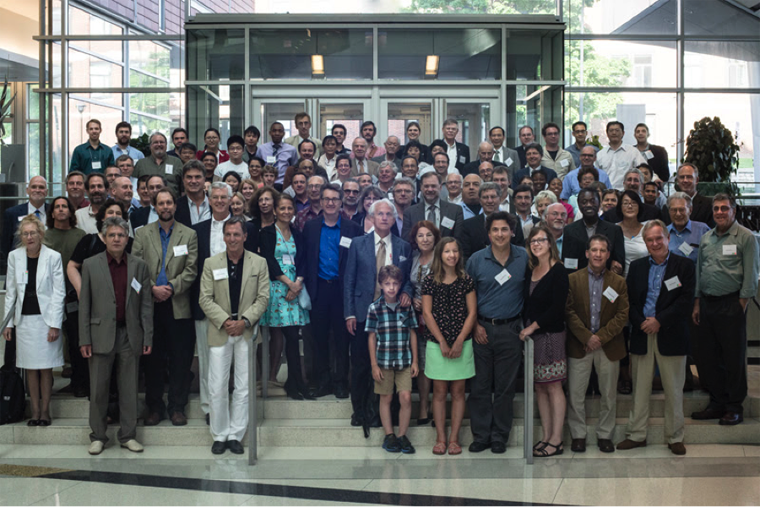Celebrating Gérard Mourou: From ultrafast to extreme light
Mourou put the University on the map in ultrafast optics when he established the Center for Ultrafast Optical Science in 1991.

 Enlarge
Enlarge
An international symposium entitled “From Ultrafast to Extreme Light” was held June 21-22, 2014 in recognition of the 70th birthday of Gérard A. Mourou, the A. D. Moore Distinguished University Professor Emeritus. Attended by over 200 participants, the symposium celebrated Prof. Mourou’s many contributions to optics.
Prof. Mourou put the University of Michigan on the map in ultrafast optics when he established the Center for Ultrafast Optical Science (CUOS) in 1991. This center houses the Hercules laser, a 300 TW laser that set a world record of intensity in 2003, and other advanced optical research. CUOS spawned several companies, including Picometrix in Ann Arbor, a pioneer in terahertz technology, and Intralase, which pioneered the use of femtosecond lasers in eye surgery.
Recognized worldwide for his work in ultrafast science and technology, Prof. Mourou has made major contributions to electronics, optoelectronics, archeology, and medicine. In ophthalmology his work on the cornea resulted in IntraLASIK technology which is marketed by IntraLase and used on more than 5 million patients. He also invented a revolutionary method of laser amplification, called Chirped Pulse Amplification (CPA), which is now included in all high intensity lasers. This technique enables the generation of intense laser light needed for fundamental physics at the level of quarks.
After retiring from the University of Michigan, Prof. Mourou was named Director of the new International Center for Zettawatt-Exawatt Science and Technology (IZEST) at Haut Collège at the École Polytechnique in France. He proposed and oversaw the creation of a major European scientific collaborative project called the Extreme Light Infrastructure (ELI). Based in the Czech Republic, Romania, and Hungary, the ELI is dedicated to the production of the most powerful laser pulses ever produced.
He is a member of the National Academy of Engineering, and a foreign member of the Russian Academy of Sciences and scientific societies in Austria and Lombardy.

 Enlarge
Enlarge
The symposium featured invited speakers, including:
- Sir David Payne, Director of Optoelectronics Research Centre University of Southampton
- Paul Corkum, Research Chair in Attosecond Photonics for the National Research Council-Canada, University of Ottawa
- Ursula Keller, Head of Research in ultrafast laser physics, ETH Zurich
- Wolfgang Sandner, Director General and CEO, Extreme Light Infrastructure, Belgium
- Bob Byer, Co-Director, Stanford Photonics Research Center
- Pisin Chen Director, Leung Center for Cosmology and Particle Astrophysics,National Taiwan University
- Wayne Knox Professor of Vision Science in the Center for Visual Science, University of Rochester
- Steve Williamson, Co-Founder and CTO of Picometrix and former research scientist with CUOS
- Janis Valdmanis, former Principal Scientist at Picometrix and deputy director of CUOS, now general manager at ThorLabs
- Theodore Norris, Gerard A. Mourou Professor of Electrical Engineering and Computer Science; Director, Center for Photonic and Multiscale Nanomaterials (C-PHOM)
- Donna Strickland, Associate Professor of Physics and Astonomy, University of Waterloo
- Tibor Juhasz, co-founder of IntraLase and former research scientist with CUOS, now Professor of Biomedical Engineering, UC Irvine
- See Leang Chin, Emeritus Professor, Laval University
- Todd Ditmire, Director, High Intensity Laser Science Group, University of Texas – Austin
- Chris Barty, CTO, National Ignition Facility and Photon Science Directorate at Lawrence Livermore National Laboratory
- Dan Blumenthal, Professor of ECE, UC Santa Barbara
- Adrian Melissinos, Professor of Physics, University of Rochester
The symposium also included a poster session featuring work by current optics students. Dean Dave Munson gave the CoE welcome remarks, and Ed Moses (Lawrence Livermore National Lab and now President of the Giant Magellan Telescope Organization) delivered the after-dinner speech. The symposium was organized and chaired by Prof. Herbert Winful, assisted by Research Scientist John Nees.
Watch the talks:
In the Media
Governor Whitmer declares 03/28/19 “Chirped Pulse Amplification Day” in recognition of the work that led to the 2018 Nobel Prize in Physics for ECE Prof. Emeritus Gerard Mourou
Governor Whitmer declares Thursday, February 28, 2019 “Chirped Pulse Amplification Day” in recognition of the work that led to the 2018 Nobel Prize in Physics for Gerard Mourou, the A. D. Moore Distinguished University Professor Emeritus of ECE.
 MENU
MENU